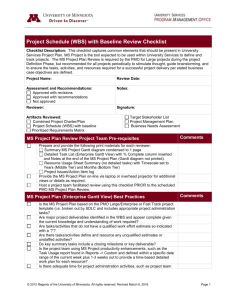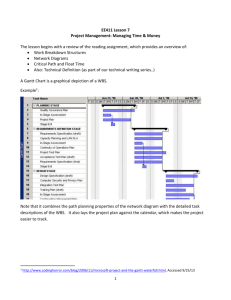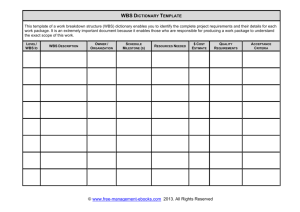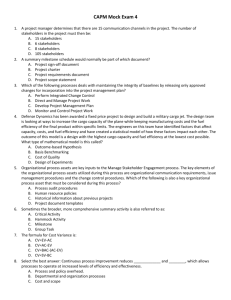Research Project Management Key Concepts
advertisement
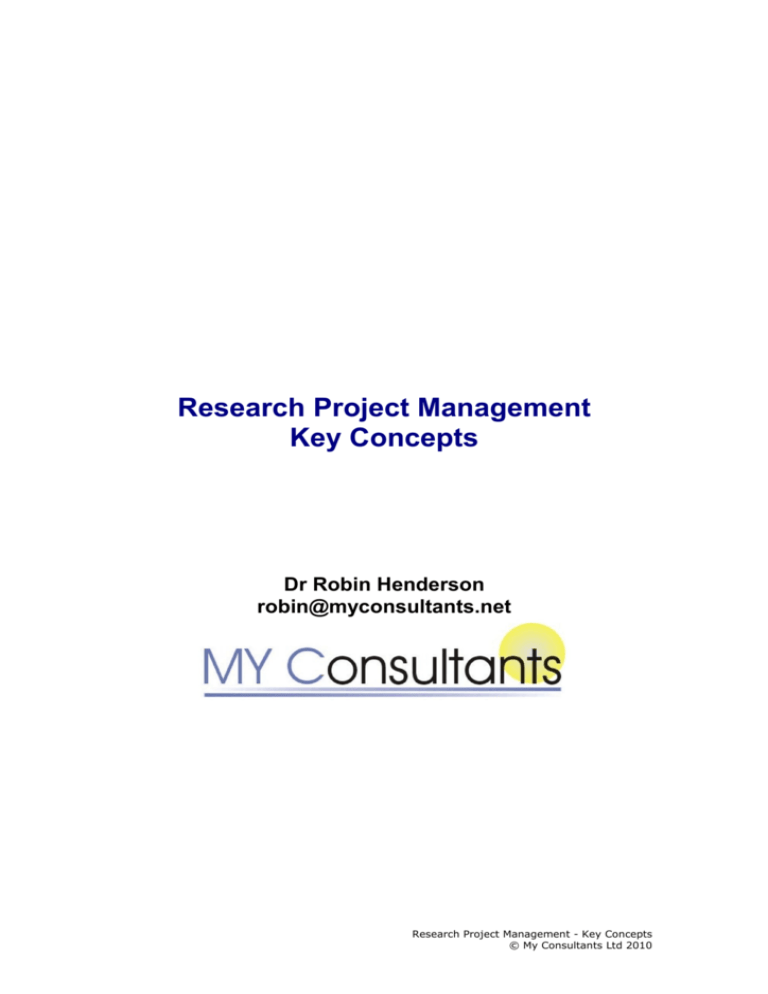
Research Project Management Key Concepts Dr Robin Henderson robin@myconsultants.net Research Project Management - Key Concepts © My Consultants Ltd 2010 Introduction The successful management of a research project depends upon the researchers ability to plan, coordinate and perform the research. Many researchers do not formally manage their research and whilst this does not necessarily mean that the research will not be completed successfully this approach has impacts on the staff whom are involved in the project. For example an unplanned approach can often lead to stress in members of the research team, crises management when deadlines are not effectively managed and the lack of time within the research to deliver effective outcomes for all the staff involved in the project. This short document outlines some of the key tools which you can utilise within research contracts to lead to more successful outcomes. Clearly understanding what success means for your project. The starting point for managing a project effectively is to have a clear understanding of what you are trying to achieve. A simple model to start to explore this is to distinguish between outputs and outcomes. Outputs are the physical deliverables of the project Outcomes are what happens as a result of the outputs For example in a clinical based trial the output could be a paper with the related outcome being the changes in clinical practise. The starting point for a project is to define what the desired outcomes are and from this the outputs can be defined. In effect you are “starting with the end in mind” and by doing this you should be able to focus the research effort. This is particularly important for PhD students where they have a relatively short period of time to develop their research skills and produce a significant piece of work – being clear about what they are trying to achieve will allow them to focus your efforts. Stakeholder planning and management. Stakeholders can be defined as “people who have an interest and involvement in the project”. Poor management of stakeholders can lead to communication issues within the project and conflict between stakeholders especially when the individual stakeholder's objectives are competing for priority within the project. One approach to examine stakeholders is to use the Winstanley stakeholder model. This approach allows us to examine who the stakeholders are and the relationships between the stakeholders. In order to do this the key steps are: Identify the key stakeholders. In doing this try to break the stakeholders into small groups as large groupings can impact on the value of the information gained from the process. Understand the transactions which are involved in the interaction with the stakeholders. For example what is the funder providing and what do they expect in return for this investment. Ensuring that transactions are clearly understood at the start of the project is important as it can avoid tension and conflict later in the project. Research Project Management - Key Concepts © My Consultants Ltd 2010 Having completed the stakeholder identification process the next step is to map them to understand the relationships between, and groupings of, the stakeholders. The mapping process involves examining the power of the stakeholders in two dimensions: • The ability of the stakeholder to influence the outcomes of the project. For example the funders (during the application stage) have a large impact on the outcomes of the project as if they do not agree with the outcomes of the project they are unlikely to fund the work. • The stakeholders ability to influence how the outcomes will be met. For example the technical and administration staff on a project are unlikely to have an impact on the outcomes of the project but are likely to have a significant impact on how the outcomes are achieved. Once this process has been completed it is possible to create a stakeholder map as shown below. What needs done Criteria Power Disempowered Comprehensive Power Operational Power How it is done? Having mapped the stakeholders in the project the next stage is to understand the impact of the results of the mapping process and to devise strategies for how to best to interact with each of the stakeholders. This is especially important within the current research environment as it is the interactions which you have with stakeholders which will lead to developing your research having real impact. For example operational power stakeholders (who often include technical and administration staff and on large collaborations the researchers) should have the overview of the project communicated to them, whist criteria power stakeholders may need the detail explained. The key outcomes of the stakeholder analysis process are: An understanding of how the stakeholders will impact on the project. An understanding of the dynamics of the stakeholders so that this can be taken into account when determining the project scope. The stakeholder process is obviously dynamic and it is a good idea to revisit this process at times within the project to identify if there are additional issues which need to be managed. Research Project Management - Key Concepts © My Consultants Ltd 2010 Developing timelines – a rolling wave approach to planning In traditional project management the approach taken to planning would to try and plan as much of the project at the start as possible. However, in a research environment this is much more difficult as the project will evolve significantly as the research progresses. One approach to managing this is to develop a rolling wave plan. In order to do this: You develop an understanding of the overall project without much detail. You then on a rolling basis fill in the detail. For example, it is possible to put together a generic plan for a PhD project which will describe at a high level what is expected within the project. For example a typical PhD plan might look like: Year 1 Define research question Read literature Write Literature review Develop required research skills Pilot studies Plan Fieldwork and Experiments Organize access to research sources Write end of year report Year 2 Continue to read literature and write up as you go along Developing a research network Data collection and analysis Fieldwork Attend conferences / present at seminars Start to think about publication Year 3 Check data for gaps and collect any final information Write papers/present at conferences Look for funding for research? Write Thesis Look for a Job It should then be possible to fill in the detail on a rolling basis – perhaps putting together a more detailed plan every 3 months. The work breakdown structure (WBS) is the basis for creating the timeline. The WBS is simply created by taking the project and splitting it down into some smaller tasks. Once you have these smaller tasks you can then split the tasks into even smaller chunks and you keep doing this until the chunks will require between 8 and 80 hours of work to complete. This level of detail allows you to manage the project without running the risk of micromanagement. Some of the benefits of using a WBS include: Understanding exactly what is involved in the project Identifying key tasks Provides a framework for delegation and resource identification Provides a method to manage and measure progress Provides a basis for developing cost estimates Research Project Management - Key Concepts © My Consultants Ltd 2010 Drives delivery of the project by having many deadlines You have more flexibility in how you arrange the activities in the project. One approach to developing WBS is to view it as a mind-map of the tasks involved in the project as shown below for the WBS of a literature review. In the rolling wave approach to the planning process the details on the WBS will be expanded as the project progresses and we have a more detailed understanding of what is required. For example in the literature review WBS we might choose to expand the Detailed Papers into a couple of key topic areas once it is clear what these topics are. After the WBS has been developed you can then start to think about how you estimate the duration of the tasks. In order to do this you should bear in mind: A task which takes you little time may take a new researcher a significantly longer period of time. If there are repetitive tasks in the research (e.g. Writing up transcripts / performing a specific experiment) you may want to do some timing of a typical instance in order to develop a realistic time scale for the whole task. You often get better results when you are working with people if you get them to indicate how long the task may take to complete. You should however do a reality check when asking someone – the biggest problem is people underestimating how long something will take to complete. Once you have the WBS and durations of the tasks you can then start to develop the Gantt chart for the project. Research Project Management - Key Concepts © My Consultants Ltd 2010 In developing the Gantt chart you will want to: Think about how you can design your project so that activities can run concurrently. This has the benefit of allowing the researchers to work on more than one task at a time which can help with their motivation especially when the work contains repetitive experimental work. Put in place the constraints between tasks that describe the logical order in which you should do the activities. At times these may be forced upon you (for example gaining ethical approval before starting the work) but at other times it is likely that you will have to use your own judgement to decide upon the logic. That the Gantt chart reflects a plan for a project and will change and adapt as the project progresses. There are a number of software packages available to help with Gantt Chart development – one of the best of the freeware packages is Gantt Project which can be downloaded at www.ganttproject.biz. Once you have developed your Gantt chart the final stage in the process of developing the timeline for the project is to check it makes sense and that the resources are in place to complete the work. One common mistake is to assume that many tasks can be overlapped and the plan does then not reflect the constraint on the resources. Once you have the Gantt chart you can then identify the critical path activities. These are the activities which if they do not start and finish on time will have an adverse effect on the duration of the project. Often in research projects these activities seem less immediately important than others (and often include items linked to career development) but if they are not managed properly can have a negative impact on both the project and the researcher's career. Managing Risk within the Project Within every project there are risks which if they occur would impact on the success of the project. For example in the research environment some of the risks which you might face include: One of the research team leaving before there contract finishes Poor quality data is obtained Key pieces of equipment breakdown Research Project Management - Key Concepts © My Consultants Ltd 2010 Someone else publishes work very similar to your before you publish your work. The secret to managing risk well is to have thought through what might go wrong and on the basis of this develop strategies to manage the key risks. In order to identify the key risks: Have a brainstorming session in which you identify all the risks which you can think of. Decide upon how much impact these risks might have on your project. In order to assess the impact you will want to think about reputation, costs and schedule impacts. Give each risk a score for impact between 1(low) and 5(very high). Decide how likely the risks are to happen. You should note that if something is certain to happen then it should not be treated as a risk but placed in the main plan. Give each risk a score for likelihood between 1 and 5. You are now in a position to prioritise the risks using a risk matrix as shown below. For any risk in your risk matrix which scores 10 and above you need to think about how you could manage the risk. For the risks we identified previously some of the methods are outlined in the table below. Research Project Management - Key Concepts © My Consultants Ltd 2010 Risk Mitigation Approach Staff Leave Regular project reports Training of other project staff in techniques Poor quality data Pilot experiments Review data frequently Build in redundancy to the data collection process Equipment Breakdown Maintenance and Spares Identify alternative locations (i.e. Can you borrow the equipment) Develop more than one stream of work Competitor analysis Networking Publish early Beaten to publish Managing the project Once you have gone through the planning process you need to think about how you are going to actively manage the project. Within this there are two key elements: Understanding how the project is progressing Decision making to get the project back on track In order to understand how the project is progressing it is useful to think about the methods you utilise to gain information about how the project is progressing. Typically most people use a combination of reports and meetings, each of which has its pros and cons. The secret is to think about what you are trying to achieve by the method of progress measurement that you use and then plan the use accordingly. For example reports are good at focusing the minds of the staff working on the project whilst meetings give a space for discussing the progress of the project and for you as the manager to assess the mood within the staff working on the project. If you identify through the progress reporting that the project is not progressing as planned then you will need to take action. The first thing to do is to avoid blaming individuals for the problems that are being experienced in the project. If you do blame individuals they are less likely to report problems in future. The second thing to do is to take a decision about the course of action. If we let the problem sit without some sort of action they are likely to escalate (problems rarely disappear). In order to take the correct action it is imperative that we take action at the cause level and not the symptom level (the classic example of this is working harder to solve a problem and discovering that no matter how hard we work the problem does not go away). In order to do this asks the question “Why?” several times till you get to the root cause of the problem and then take action at this level. Research Project Management - Key Concepts © My Consultants Ltd 2010 Managing the Project Budget In research projects the rules governing exactly how you should manage your budget will depend upon your funder but some basic concepts apply to all budget management. Understand your commitments. Commitments are the items of spend which you know you will need to make in the future. For example if you were to employ an individual on a one year contract then all the monies related to paying that individual (including pension and NI costs) are committed from the time the offer of employment is made. Similarly if you have to pay a license cost for access to data, and you know you will need this for the duration of the project, your budget should reflect what you have committed for this cost. Understand which budgets are yours to manage. After you have employed someone on a research contract the likelihood is that you will not need to directly manage the budget attached to that salary once the contract has been put in place. Similarly under full economic costing it is likely that you will any involvement in the management of estate costs. However, you will need to manage tightly the budgets related to travel, consumables, equipment and other costs (such as printing costs). So find out which budgets you need to manage and focus on these. Track your spend. The monthly budget reports will tell you what you have charged that month to each of the main budget headings. For each budget heading keep track of: what you were awarded (A) what you have already committed to spend on that budget in the future (B) what you have already spent on that budget (C) how much you have left to play with = A – B - C The real success to managing the project budget is about understanding the commitments which you have made as this will give you a realistic available budget. Finding time to manage the project One of the challenges that people face when trying to manage research is that they might feel that the management elements (especially project planning) are not doing work. The reality is that if an activity adds value to the project then it is useful work and certainly an element of planning is likely to move the research project towards a successful outcome. The challenge for you as the research manager is to find a recipe of project management that works within the context of your research without over planning. Research Project Management - Key Concepts © My Consultants Ltd 2010


